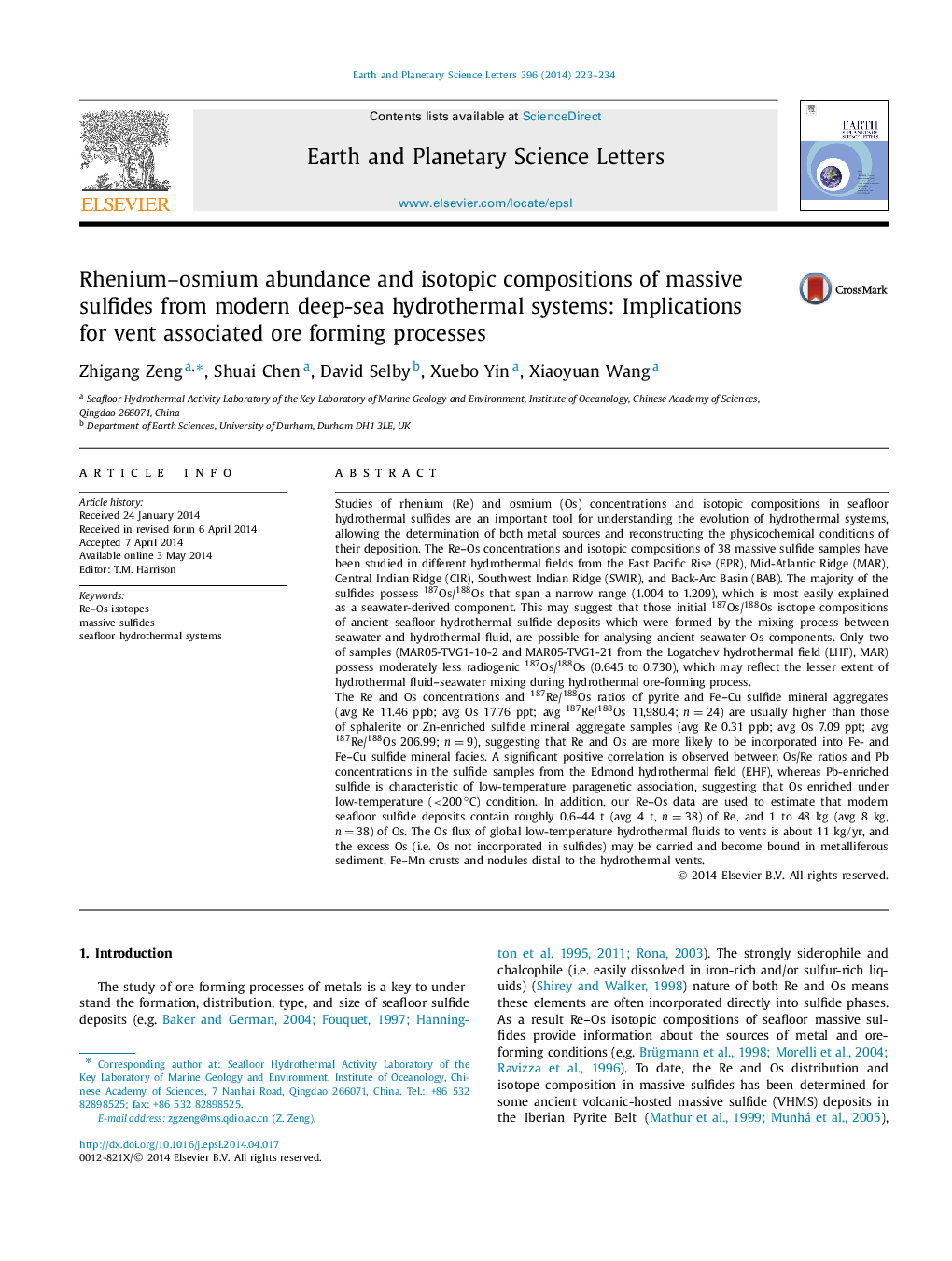| کد مقاله | کد نشریه | سال انتشار | مقاله انگلیسی | نسخه تمام متن |
|---|---|---|---|---|
| 6429557 | 1634760 | 2014 | 12 صفحه PDF | دانلود رایگان |

- Seawater is a significant source of Re and Os in seafloor massive sulfides.
- Initial 187Os/188Os ratios of ancient sulfides can trace ancient seawater component.
- 187Os/188Os ratios of seafloor massive sulfides is not controlled by mineral facies.
- Os is enriched in low-temperature conditions.
- Global seafloor sulfide deposits contain roughly 4 tonnes of Re and 8 kg of Os.
Studies of rhenium (Re) and osmium (Os) concentrations and isotopic compositions in seafloor hydrothermal sulfides are an important tool for understanding the evolution of hydrothermal systems, allowing the determination of both metal sources and reconstructing the physicochemical conditions of their deposition. The Re-Os concentrations and isotopic compositions of 38 massive sulfide samples have been studied in different hydrothermal fields from the East Pacific Rise (EPR), Mid-Atlantic Ridge (MAR), Central Indian Ridge (CIR), Southwest Indian Ridge (SWIR), and Back-Arc Basin (BAB). The majority of the sulfides possess 187Os/188Os that span a narrow range (1.004 to 1.209), which is most easily explained as a seawater-derived component. This may suggest that those initial 187Os/188Os isotope compositions of ancient seafloor hydrothermal sulfide deposits which were formed by the mixing process between seawater and hydrothermal fluid, are possible for analysing ancient seawater Os components. Only two of samples (MAR05-TVG1-10-2 and MAR05-TVG1-21 from the Logatchev hydrothermal field (LHF), MAR) possess moderately less radiogenic 187Os/188Os (0.645 to 0.730), which may reflect the lesser extent of hydrothermal fluid-seawater mixing during hydrothermal ore-forming process.The Re and Os concentrations and 187Re/188Os ratios of pyrite and Fe-Cu sulfide mineral aggregates (avg Re 11.46 ppb; avg Os 17.76 ppt; avg 187Re/188Os 11,980.4; n=24) are usually higher than those of sphalerite or Zn-enriched sulfide mineral aggregate samples (avg Re 0.31 ppb; avg Os 7.09 ppt; avg 187Re/188Os 206.99; n=9), suggesting that Re and Os are more likely to be incorporated into Fe- and Fe-Cu sulfide mineral facies. A significant positive correlation is observed between Os/Re ratios and Pb concentrations in the sulfide samples from the Edmond hydrothermal field (EHF), whereas Pb-enriched sulfide is characteristic of low-temperature paragenetic association, suggesting that Os enriched under low-temperature (<200â°C) condition. In addition, our Re-Os data are used to estimate that modern seafloor sulfide deposits contain roughly 0.6-44 t (avg 4 t, n=38) of Re, and 1 to 48 kg (avg 8 kg, n=38) of Os. The Os flux of global low-temperature hydrothermal fluids to vents is about 11 kg/yr, and the excess Os (i.e. Os not incorporated in sulfides) may be carried and become bound in metalliferous sediment, Fe-Mn crusts and nodules distal to the hydrothermal vents.
Journal: Earth and Planetary Science Letters - Volume 396, 15 June 2014, Pages 223-234